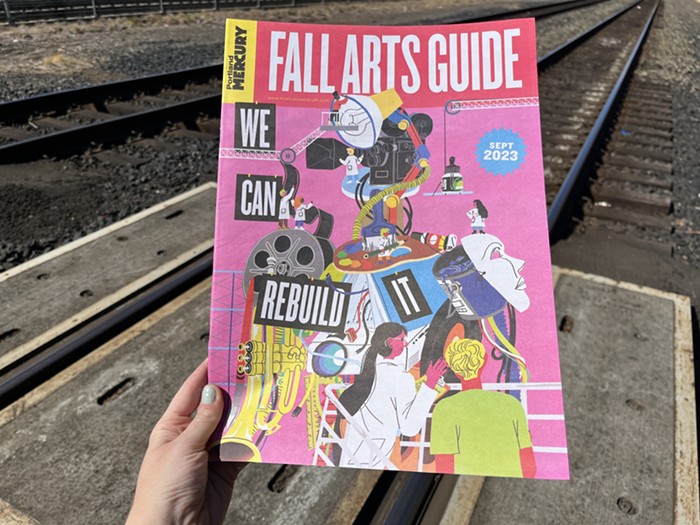[Editor's Note: Congrats to Bret Hodgert, the winner of "A Glowing Feature in the Mercury" featured in our online charity auction! Bret's winning and generous bid went to Raphael House, a great nonprofit dedicated to assisting survivors of domestic violence. Thanks again, Bret, and we hope you enjoy your story as much as we did!]
THE FIRST STORY is in the planks around us.
"All the fir going around these walls came out of a place south of Salem called Fairview Training Center," says Bret Hodgert, owner of Old Portland Hardware & Architectural, gesturing to the golden-hued wood lining the walls of his multi-chamber architectural salvage center on SE Division. Fairview Training Center, built in 1907, was the original State Institution for the Feeble-Minded, "where they took kids with Downs, autism, Fetal Alcohol Syndrome, behavioral issues, anything," explains Hodgert. "Parents would drive up, drop their kids off, and they'd never be seen again."
Hanging on these walls is an array of both functional and decorative items, ones that might've gone forgotten if it weren't for Hodgert. An ox skull shares wall space with a series of stained glass windows—below is a four-foot-tall metal birdcage filled with antique door handles, the inside bits from discarded pocket watches, and mysterious gear sets suspended from the cage's metal bars. I take it all in as Hodgert continues his story about the fir he salvaged from Fairview.
"It was a 700-acre place and the original buildings were these big huge antebellum buildings... but up in the attics," says Hodgert with treasure behind his eyes, "the attics were lined with fir—this beautiful, clear fir up there—and I thought, 'This would be great for the walls of the shop.'"
Behind me, past a tight arrangement of displays showcasing horse bits, branding irons, antique books, small paintings, and similar miscellany, is a meticulously organized collection of old-school escutcheons (door knob strike plates), hung in neat rows of Victorian, art deco, and other design styles. But Hodgert is still in the attic, still in Fairview reliving the hunt.
"So I get in there," he says, "there's no power, there's no light, I'm on the third or fourth floor up in the attic pulling this stuff off by hand with a crowbar... [when] I discovered there were rows of wire hooks and stenciled names above them. Because [the tenants] lived in the wards downstairs and there was no storage for their stuff down there, each kid would have a winter coat and a pair shoes hanging up in the attic."
He looks out over his kingdom of fir, made brighter by the dozens of chandeliers and light fixtures hanging on display, finishing his story.
"If you look around the walls you'll see the names. It feels really good to bring the kids out and give them their day."
As is evident, unlike antique collectors and others in the salvage profession, for Hodgert it’s not so much about finding the best price for the most collectible object, but finding the best-looking stuff with the most interesting history—giving both the beauty and the story a stage.
To fill in the stage, Hodgert has gone as far east as Cleveland on cross-country buying trips. He says he’s found his rhythm for such missions. He’ll come across a particularly must-have item online, fly to it, and rent a 35-foot Penske truck to fill with whatever he can find on the way back. Most deals are found on the ground, by paying attention to any roadside indications that cool old stuff is up ahead. The “crown jewel of the shop,” a museum-quality, 100-plus-year-old window, hand cut and polished from “a single piece of lead crystal,” came to him on such a trip. Hodgert went to Detroit to buy a bulk lot of antique windows (which now occupy the upper level of Old Portland’s back room, alongside other larger appliances and furniture) from a 90-year-old collector. Aside from the bulk lot were five pieces being sold individually, one being the aforementioned pane of ornately cut crystal. Hodgert was so struck by the craftsmanship of this window that he had to have it in his collection. Cut-glass experts say it’s unlike anything they’ve seen—that it’s so large and detailed that it should’ve been impossible to construct.
It takes a trained eye to recognize such a find, and Hodgert’s training has been lifelong, at varying capacities. “When I was kid I wanted nothing more than to be one of those archaeologists in National Geographic,” he explains, “digging up things... [and] spending all this time figuring out what [they are]—unveiling the mystery.”
Later in life, this fantasy became reality. “It came full circle when years later I realized that I had realized my dream: I’m digging stuff up, nobody knows what it is, and I figure it out.”
But Hodgert didn’t go straight from his archaeologist daydreams to sifting through America’s architectural rubble. “I lived in an old 1902 house for a while [and] in the late ’80s, early ’90s, ended up working in remodeling with a gentleman,” he says. “And then I worked for one of the competitors here in town for 10 years, selling and buying in architectural salvage, refining my knowledge there.” Yet he wanted to do it his own way.
Hodgert began amassing his collection four years ago and opened up shop in August of 2007, in what he estimates to be the last month in which the local housing market was level—not the most opportune time to start a business servicing homeowners. “It’s been a tough three and a half years, but I’m scrappy and stubborn and I’ve made it this far,” he says. “I love what I do. I’m not going down, I’m slowly creeping up, and I think that in this economy if I can be slowly creeping up, I’ll make it.” Part of that creeping up comes in avoiding the same-olds of other salvage and antique shops.
“It’s not just architectural salvage,” says Hodgert, “I wanted a place that fit my character.” And in reflecting Hodgert’s character, he began to modify items from his inventory, bringing new functionality to timeless looks—speaking to his love for the steampunk anachronisms from the novels of his youth. Hodgert says that the lighting fixtures he makes from old industrial salvage—clunky paint pressurizers, torches, and heat lamps, retrofitted with wiring and bulbs—get a good bit of attention, wowing designers with their “rustic but elegant” feel.
More and more, his clientele comes for his unique brand of visual character. It’s not just old house enthusiasts tracking down a particular doorknob or people in need of repairs (though there are quite a few those, and Hodgert’s happy to oblige), there are also artists in search of that just-right piece of metal, or new homeowners, restaurateurs, and start-up businesses looking to bring some style to their decor.
But Hodgert’s fondness of visual appeal doesn’t seem to trump his dedication to the history of the objects he’s salvaging. One time a man driving up SE Division noticed his last name on the side of an old wooden barrel Hodgert had put outside to attract customers. The man stopped to inquire about the barrel’s origins, and it turned out that it belonged to his grandfather nearly 100 years prior—confirmed by a business card stapled to the underside of the barrel’s base—and was lost when members of the local Japanese American population were taken to internment camps in the ’40s, their businesses forfeited and their possessions left to fate.
But as this fate would have it, the price of this family relic was the story of its travels; Hodgert gave the man the barrel free of charge, because in certain businesses, currency can take many forms, and Hodgert’s Old Portland Hardware & Architectural is one such establishment. “Paid in full by a good story,” says Hodgert with a grin.













